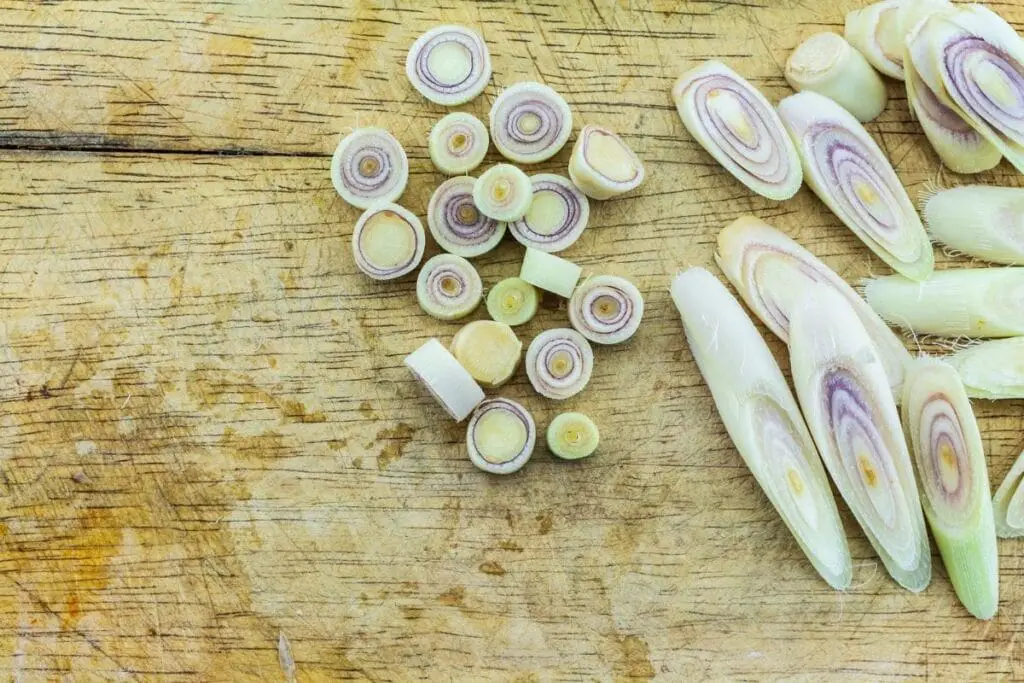In summary: Lemongrass can be substituted with dry lemongrass, lemon zest, preserved lemon, lemon balm, lemon verbena leaves, etc. Each alternative offers a unique flavor profile and can be used in various dishes like salads, sauces, and fish. Consider the specific taste you want to achieve when selecting the best substitute.
When life gives you lemons, make lemonade. When life gives you lemongrass, make delicious Thai curry. This herb looks very similar to a green onion. It has a small white/green, bulbous bottom and darker, bright green, long grass-like blades at the top end. It is generally only the tough stalk of lemongrass that is used in cooking. The leaves can also be used, but this is less common.
If you’re a fan of Thai, Vietnamese, Malaysian, or Indonesian cuisine, you are probably familiar with lemongrass since it is a popular flavoring agent in Southeast Asian dishes. If you need a substitute for lemongrass, whether in a stew, soup, curry, dessert, or drink, we have a few suitable options that can save you a trip to the store.
It is important to choose a lemongrass substitute that mimics the most desirable flavor properties in your dish whether it be sweet lemony nuances or bold accents. In this guide, we’ll help you choose the best option according to the dish you are making for flawlessly delectable results.
How is Lemongrass Used?
The lemongrass plant also goes by the name fever grass. It has a sharp lemony flavor with a light fragrant sweetness. The fibrous, woody stalks are pounded, chopped, or bent back and forth to release the fragrant oils. The stalk is then added to dishes, marinades, or grilled meats to infuse flavor.
As with bay leaves, whole star anise, and cinnamon sticks, you need to remove the lemongrass stalk from the dish before serving. If you don’t want that hassle, powdered lemongrass is a good alternative or you can make a paste by grinding it finely in a food processor.
Fresh stalks work well in dishes that simmer for long periods as this allows plenty of time for flavors to infuse. Soups, stews, curries, slow-roasted meat, and stuffed meats are all good examples where dry and fresh stalks can be used since they’ll rehydrate while cooking.
Lightly pounded or bruised stalks are also a great way to infuse tea, spirits, or use them as a cocktail stirrer. You can add one or two stalks to a bottle of vodka and let it infuse for a week before enjoying.
Storing Lemongrass
Lemongrass will last long if you store it correctly. The stalks can be wrapped loosely in a kitchen or paper towel and kept in the fridge for a few weeks. Additionally, it can be stored in the freezer as whole stalks, sliced, or mined. Powdered or dried lemongrass is best stored in a dark, cool, dry place in an airtight container.
What to Look for in a Lemongrass Alternative
When choosing a lemongrass substitute you first want to consider what the prominent flavor accents in your dish are. This can be lemony, floral sweetness, or slight gingery nuances.
Lemongrass does not have the bitterness of regular lemons and does not have the spicy, pungency of ginger. Instead, it mimics both these flavor profiles more subtly with added earthiness and hints of mint for an exotic depth of flavor.
Best Lemongrass Substitutes
1. Dry Lemongrass
The dried type will give you the most authentic and closely matched lemongrass flavor, although it won’t be as sharp as the fresh stems. It is best used in dishes that will simmer for a while to allow it to rehydrate and release flavor. Since it is often in a powder form it can be overpowering if too much is added since the flavor will be intensified.
Substitute Quantity: Replace one stalk of lemongrass with one teaspoon of dried powder.
Best used in: Marinades, salad dressings, spice rubs, desserts, sauces, curry, and soup.
2. Lemon Zest
If you have fresh lemons at home, you don’t need to look any further. Lemon zest has the same fresh citrus notes and slight zing. The white pith of a lemon bitter taste, so make sure to only zest the very outer yellow peel.
Substitute Quantity: Replace one stalk with the zest of half a lemon
Best used in: Any recipe that calls for lemongrass
3. Preserved Lemon
The preservation of lemons in a mixture of salt, fresh lemon juice, and occasionally spices, results in a much softer fruit and edible skin. It has a mild tangy and citrusy flavor. You can use both the peel and the pulp of the preserved lemon. It will be pretty salty and is not suitable to use as a substitute in desserts.
Substitute Quantity: Replace one stalk with half a preserved lemon
Best used in: Seafood dishes including prawns, shrimp, and fish
4. Lemon Balm
Lemon balm is a herb that’s part of the mint family. It has a delicate citrus fragrance with a touch of sweetness. This is a good option for desserts and sweet dishes, although it can be added to almost any recipe as a replacement. To get the most out of these herbs, add them closer to the end of the cooking time. Excessive exposure to heat over a longer period will destroy the fragrant quality of the herb.
Substitute Quantity: Substitute 1 stalk with 4 lemon balm leaves
Best used in: Desserts, lemon curd tart, lemon syrups, broth, sauces, pesto, vinaigrette, and soup.
5. Lemon Verbena Leaves
Lemon verbena is another herb with a sweet citrus flavor but it is somewhat stronger than lemon balm. The herbs are from completely different plant families and are not related. Lemon verbena can be intense if you add too much but just the right amount can be incredibly fragrant in almost any dish. You may want to remove the leaves before serving your dish when using them whole.
Substitute Quantity: Replace 1 stalk with 2 verbena herb leaves
Best used in: Desserts, syrups, sauces, broth, stews, curry, cake, salad, meat dishes, fish, and vinaigrettes. This is also a great option for making tea. Either submerge the torn leaves in hot water or use a tea infuser. Let them steep and if desired add honey for a fragrant and healthy tea.
6. Kaffir Lime Leaves
Also known as Makrut Thai lime leaves, these come from the same bush as kaffir lime fruits. The leaves are tough and not suitable to be eaten whole. They are great for infusing strong citrus notes into dishes and then being removed before serving the dish. They have a good amount of tang and are best left to infuse for a while during simmering. The lime zest and lime juice can also be used in cooking.
Substitute Quantity: Use 1 kaffir lime leaf only as a substitute for one lemongrass stalk
Best used in: Any dishes with a liquid base requiring simmering time. This includes curry, stew, broth, and soup.
7. Lemongrass Paste
This paste, also known as Kreung, will probably only be stocked in your pantry if you enjoy cooking a lot of Asian fusion food. Since the paste contains lemongrass, it will give you the same flavor notes. The paste does, however, also contain ginger, garlic, galangal, and shallots. This makes it ideal for savory dishes but not for sweet desserts or drinks.
Substitute Quantity: Use one tablespoon of paste as an alternative for one stalk
Best used in: Curry, meat dishes, marinades, soups, stir fries, and stews.
8. Japanese Yuzu
Yuzu won’t be commonly available everywhere, but if it is something you have at home or can easily get, this can be a great substitute in sweet and savory dishes. The Japanese citrus fruit looks very similar to a lemon, with a slightly rounder shape. It has a distinctive flavor similar to that of mandarin oranges and lemon combined.
Yuzu is more acidic than lemongrass but pairs well with similar flavor profiles with the same citrus burst. Yuzu is not a very juice fruit so you will have to put in some effort when squeezing out the juice.
Substitute Quantity: To replace one stalk use the juice and zest of 2 yuzu fruits
Best used in: Fish dishes, curry, and vinaigrettes. It can also be incorporated into sweet dishes.
9. Arugula and Lemon Zest Combo
This may sound a little odd, but just a small amount of arugula can bring an earthy and slightly peppery note to your dish that adds a beautiful depth of flavor. Since lemongrass and arugula both pair well with beef, pork, seafood, poultry, and vegetable dishes, this combination is very versatile.
Substitute Quantity: For one stalk, use 1 teaspoon of lemon zest and only one arugula leaf as a substitute.
Substitution Tip: Adding more than one medium-sized arugula leaf will intensify the peppery notes while completely overpowering the citrus touch. Do not grate or zest the white pith, only use the yellow zest of the lemon peel.
Best used in: Any liquid-based savory dishes that require a replacement.
10. Grated Ginger and Fresh Coriander
Fresh ginger root and coriander both have potent floral and aromatic qualities. The combination of the two offers a fresh, zingy, and perfumed herbal flavor. Use fresh ingredients as a substitute to get the same freshness that lemongrass offers.
Substitute Quantity: To substitute one stalk, use 2 teaspoons of finely grated ginger mixed with 2 teaspoons of coriander stalks. You may want to start with half the amount and add to taste depending on the type and size of the dish you are making since these are strong flavors.
Best used in: soups, broths, curry
See more: Coriander alternatives
FAQ
These two plants are different species but they are very closely related. They smell and look very similar. Citronella has reddish stems while lemongrass varies in shades of green.
Yes, lemongrass contains citronella oil which is a natural mosquito deterrent.
Yes. The best way to use lemongrass is to trim the base of the stalk and peel the hard outer coat. Use the back of a knife to bruise the stalk. This will enhance flavor infusion when adding it to your cooking liquid. Alternatively, slice it into rings.
In the UK, you can use lemon zest or lemon balm as a substitute for lemongrass to achieve a similar citrusy and aromatic flavor in your dishes.
Conclusion
With its fragrant lemon notes, ginger undertones, and earthy accents, fresh lemongrass is a unique ingredient to find a replacement for. With so many zingy citrusy herbs and fruits around, you’re bound to find something that mimics the right flavor profile in your dish.
When making desserts and sweet syrups, opt for lemon balm and lemon verbena. For bold savory dishes, lemongrass paste and herb combinations can bring extra depth and complexity. Happy cooking!
*image by anginta/depositphotos









